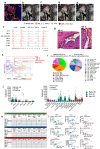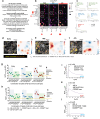Temporo-spatial cellular atlas of the regenerating alveolar niche in idiopathic pulmonary fibrosis
- PMID: 40759629
- PMCID: PMC12322046
- DOI: 10.1038/s41467-025-61880-1
Temporo-spatial cellular atlas of the regenerating alveolar niche in idiopathic pulmonary fibrosis
Abstract
Healthy alveolar repair relies on the ability of alveolar stem cells to differentiate into specialized epithelial cells for gas exchange. In chronic fibrotic lung diseases such as idiopathic pulmonary fibrosis (IPF), this regenerative process is abnormal but the underlying mechanisms remain unclear. Here, using human lung tissue that represents different stages of disease and a 33-plex single-cell imaging mass cytometry (IMC), we present a high-resolution, temporo-spatial cell atlas of the regenerating alveolar niche. With unbiased mathematical methods which quantify statistically enriched interactions, CD206himacrophage subtype and an alveolar basal intermediate epithelial cell emerge as the most statistically robust spatial association in the epithelial and immune cell interactome, found across all stages of disease. Spatially resolved receptor-ligand analysis further offers an in silico mechanism by which these macrophages may influence epithelial regeneration. These findings provide a foundational step toward understanding immune-epithelial dynamics in aberrant alveolar regeneration in IPF.
© 2025. The Author(s).
Conflict of interest statement
Competing interests: The authors declare no competing interests apart from JS who is part of the Scientific Advisory Board for Mogrify (fees to Newcastle University).
Figures






References
MeSH terms
Grants and funding
LinkOut - more resources
Full Text Sources

